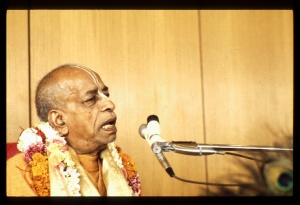CC Madhya 24.163: Difference between revisions
m (1 revision(s)) |
No edit summary |
||
| Line 1: | Line 1: | ||
{{ | [[Category:Sri Caitanya-caritamrta - Madhya-lila Chapter 24|C163]] | ||
<div style="float:left">'''[[Sri Caitanya-caritamrta|Śrī Caitanya-caritāmṛta]] - [[CC Madhya|Madhya-līlā]] - [[CC Madhya 24|Chapter 24: The Sixty-One Explanations of the Atmārāma Verse]]'''</div> | |||
<div style="float:right">[[File:Go-previous.png|link=CC Madhya 24.162|Madhya-līlā 24.162]] '''[[CC Madhya 24.162|Madhya-līlā 24.162]] - [[CC Madhya 24.164|Madhya-līlā 24.164]]''' [[File:Go-next.png|link=CC Madhya 24.164|Madhya-līlā 24.164]]</div> | |||
{{CompareVersions|CC|Madhya 24.163|CC 1975|CC 1996}} | |||
{{RandomImage}} | |||
==== TEXT 163 ==== | ==== TEXT 163 ==== | ||
<div | <div class="verse"> | ||
urukrame ahaitukī kāhāṅ kona artha | :urukrame ahaitukī kāhāṅ kona artha | ||
ei tera artha kahiluṅ parama samartha | :ei tera artha kahiluṅ parama samartha | ||
</div> | </div> | ||
| Line 12: | Line 16: | ||
==== SYNONYMS ==== | ==== SYNONYMS ==== | ||
<div | <div class="synonyms"> | ||
''urukrame''—unto the Supreme Personality of Godhead, who acts uncommonly; ''ahaitukī''—the word ''ahaitukī''; ''kāhāṅ''—wherever; ''kona''—some; ''artha''—import; ''ei''—in this way; ''tera artha''—thirteen imports; ''kahiluṅ''—I have explained; ''parama''—supremely; ''samartha''—complete. | |||
</div> | </div> | ||
| Line 19: | Line 23: | ||
==== TRANSLATION ==== | ==== TRANSLATION ==== | ||
<div | <div class="translation"> | ||
"The word 'ahaitukī' is always applicable to the Supreme Personality of Godhead, Urukrama. In this way I have described thirteen complete meanings [of the ātmārāma verse]. | |||
</div> | </div> | ||
| Line 26: | Line 30: | ||
==== PURPORT ==== | ==== PURPORT ==== | ||
<div | <div class="purport"> | ||
The thirteen meanings of the ātmārāma verse mentioned here are based on the following meanings for the word ātmārāma: (1) sādhaka, the neophyte performer; (2) brahma-maya, one absorbed in the thought of impersonal Brahman; (3) prāpta-brahma-laya, one who has actually attained Brahman perfection; (4) mumukṣu, one who desires liberation; (5) jīvan-mukta, one who is liberated in this life; (6) prāpta-svarūpa, one who has attained his original constitutional position; (7) nirgrantha-muni, a completely liberated saint; (8) sagarbha-yogārurukṣu, a yogī meditating upon the four-handed Viṣṇu form and desiring yogic perfection; (9) nigarbha-yogārurukṣu, one who is trying for perfection in impersonal meditation; (10) sagarbha-yogārūḍha, one who has been elevated to the platform of yogic perfection by meditating on the Viṣṇu form; (11) nigarbha-yogārūḍha, an impersonal yogī on the platform of perfection; (12) sagarbha-prāpta-siddhi, one who has attained the perfectional stage by meditating on the Viṣṇu form; (13) nigarbha-prāpta-siddhi, one who has attained perfection by practicing impersonal meditation. | The thirteen meanings of the ''ātmārāma'' verse mentioned here are based on the following meanings for the word ''ātmārāma:'' (1) ''sādhaka'', the neophyte performer; (2) ''brahma-maya'', one absorbed in the thought of impersonal Brahman; (3) ''prāpta-brahma-laya'', one who has actually attained Brahman perfection; (4) ''mumukṣu'', one who desires liberation; (5) ''jīvan-mukta'', one who is liberated in this life; (6) ''prāpta-svarūpa'', one who has attained his original constitutional position; (7) ''nirgrantha-muni'', a completely liberated saint; (8) ''sagarbha-yogārurukṣu'', a ''yogī'' meditating upon the four-handed Viṣṇu form and desiring yogic perfection; (9) ''nigarbha-yogārurukṣu'', one who is trying for perfection in impersonal meditation; (10) ''sagarbha-yogārūḍha'', one who has been elevated to the platform of yogic perfection by meditating on the Viṣṇu form; (11) ''nigarbha-yogārūḍha'', an impersonal ''yogī'' on the platform of perfection; (12) ''sagarbha-prāpta-siddhi'', one who has attained the perfectional stage by meditating on the Viṣṇu form; (13) ''nigarbha-prāpta-siddhi'', one who has attained perfection by practicing impersonal meditation. | ||
</div> | </div> | ||
__NOTOC__ | |||
<div style="float:right; clear:both;">[[File:Go-previous.png|link=CC Madhya 24.162|Madhya-līlā 24.162]] '''[[CC Madhya 24.162|Madhya-līlā 24.162]] - [[CC Madhya 24.164|Madhya-līlā 24.164]]''' [[File:Go-next.png|link=CC Madhya 24.164|Madhya-līlā 24.164]]</div> | |||
__NOTOC__ | |||
__NOEDITSECTION__ | |||
Revision as of 12:06, 14 September 2021

A.C. Bhaktivedanta Swami Prabhupada
TEXT 163
- urukrame ahaitukī kāhāṅ kona artha
- ei tera artha kahiluṅ parama samartha
SYNONYMS
urukrame—unto the Supreme Personality of Godhead, who acts uncommonly; ahaitukī—the word ahaitukī; kāhāṅ—wherever; kona—some; artha—import; ei—in this way; tera artha—thirteen imports; kahiluṅ—I have explained; parama—supremely; samartha—complete.
TRANSLATION
"The word 'ahaitukī' is always applicable to the Supreme Personality of Godhead, Urukrama. In this way I have described thirteen complete meanings [of the ātmārāma verse].
PURPORT
The thirteen meanings of the ātmārāma verse mentioned here are based on the following meanings for the word ātmārāma: (1) sādhaka, the neophyte performer; (2) brahma-maya, one absorbed in the thought of impersonal Brahman; (3) prāpta-brahma-laya, one who has actually attained Brahman perfection; (4) mumukṣu, one who desires liberation; (5) jīvan-mukta, one who is liberated in this life; (6) prāpta-svarūpa, one who has attained his original constitutional position; (7) nirgrantha-muni, a completely liberated saint; (8) sagarbha-yogārurukṣu, a yogī meditating upon the four-handed Viṣṇu form and desiring yogic perfection; (9) nigarbha-yogārurukṣu, one who is trying for perfection in impersonal meditation; (10) sagarbha-yogārūḍha, one who has been elevated to the platform of yogic perfection by meditating on the Viṣṇu form; (11) nigarbha-yogārūḍha, an impersonal yogī on the platform of perfection; (12) sagarbha-prāpta-siddhi, one who has attained the perfectional stage by meditating on the Viṣṇu form; (13) nigarbha-prāpta-siddhi, one who has attained perfection by practicing impersonal meditation.